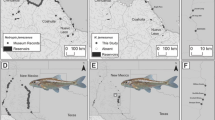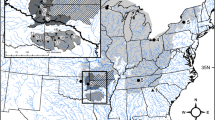Abstract
The widespread introduction of Largemouth Bass (Micropterus salmoides) and Florida Bass (M. floridanus) to establish sport fisheries represents a significant conservation concern given their role as apex predators and their ability to alter community diversity and species abundance. In regions like southern Africa, which has both high levels of aquatic endemism and imperilment, limiting the spread of invasive predators is a primary goal of current alien species legislation. Here, we applied two panels of species-diagnostic SNPs for a total of 60 markers to map the distribution of Largemouth Bass, Florida Bass, and their hybrids in 13 southern African water bodies. Using Bayesian clustering algorithms we documented the introgression of Florida Bass alleles across a broad geographic range, from the Cape Floristic region of South Africa to Mozambique. Several populations previously considered pure Largemouth Bass based on mitochondrial DNA sequences were found to consist exclusively of hybrids. Samples collected from Lake Chicamba, which was initially established with pure Largemouth Bass, are now almost exclusively comprised of Florida Bass alleles (89.3 % Florida Bass). The estimated hybrid class of sampled fish (e.g., F1 hybrid, pure Largemouth Bass, pure Florida Bass) showed that with few exceptions, populations were dominated by a single hybrid class. The present work provides enhanced resolution of the distribution and dynamics of Florida Bass, Largemouth Bass, and their hybrids in southern Africa.




Similar content being viewed by others
References
Allen R, Cato C, Dennis C et al (2009) Condition relative to phenotype for bass populations in southern Arkansas lakes. J Ark Acad Sci 63:20–27
Amish SJ, Hohenlohe PA, Painter S et al (2012) RAD sequencing yields a high success rate for Westslope cutthroat and Rainbow trout species-diagnostic SNP assays. Mol Ecol Resour 12:653–660
Anderson EC, Thompson EA (2002) A model-based method for identifying species hybrids using multilocus genetic data. Genetics 160:1217–1229
Avise J, Pierce P, Van Den Avyle M et al (1997) Cytonuclear introgressive swamping and species turnover of bass after an introduction. J Hered 88:14–20
Bailey RM, Hubbs CL (1949) The black basses (Micropterus) of Florida, with description of a new species. Occasional Papers of the Museum of Zoology University of Michigan 516
Cambray JA (2003) Impact on indigenous species biodiversity caused by the globalisation of alien recreational freshwater fisheries. Hydrobiologia 500:217–230
Chew RL (1974) Early life history of the Florida largemouth bass. Game and Fresh Water Fish Commission, Fishery Bulletin 7, Tallahassee, Florida
Childers WF (1979) The effect of a heated effluent on the frequency of two alleles at the Mdh-B locus in largemouth bass, Micropterus salmoides. In: Philipp DP, Childers WF, Whitt WF (eds) Evaluation of a cooling lake fishery, vol III. Electric Power Research Institute, Palo Alto, p 45
Della Croce P, Poole GC, Luikart G (2016) Detecting and quantifying introgression in hybridized populations: simplifying assumptions yield overconfidence and uncertainty. Mol Ecol Resour 16:1287–1302
Della Croce P, Poole GC, Payn RA et al (2017) Early detection of nonnative alleles in fish populations: when sample size actually matters. Fisheries 42:44–56
DeMoor I, Bruton M (1988) Atlas of alien and translocated indigenous aquatic animals in southern Africa. CSIR, National Scientific Programmes Unit, p 317
Drenner RW, Baca RM, Gilroy JS et al (2002) Community responses to piscivorous largemouth bass: a biomanipulation experiment. Lake Reserv Manag 18:44–51
Ellender BR, Weyl OLF (2014) A review of current knowledge, risk and ecological impacts associated with non-native freshwater fish introductions in South Africa. Aquat Invasions 9:117–132
Fields R, Lowe SS, Kaminski C et al (1987) Critical and chronic thermal maxima of northern and Florida largemouth bass and their reciprocal F1 and F2 hybrids. Trans Am Fish Soc 116:856–863
Forshage A, Fries L (1995) Evaluation of the Florida largemouth bass in Texas, 1972–1993. In: Schramm H Jr, Piper RG (eds) Uses and effects of cultured fishes in aquatic ecosystems. American Fisheries Society, Symposium, pp 484–491
Francis RM (2017) pophelper: an R package and web app to analyse and visualize population structure. Mol Ecol Resour 17:27–32
García-Berthou E (2007) The characteristics of invasive fishes: what has been learned so far? J Fish Biol 71:33–55
Gompert Z, Alex Buerkle C (2010) introgress: a software package for mapping components of isolation in hybrids. Mol Ecol Resour 10(2):378–384
Hargrove JS, Weyl OLF, Allen MS et al (2015) Using tournament angler data to rapidly assess the invasion status of alien sport fishes (Micropterus spp.) in southern Africa. PLoS ONE 10:e0130056
Hargrove JS, Weyl O, Austin JD (2017) Reconstructing the introduction history of an invasive fish predator in South Africa. Biol Invasions 19:2261–2276
Harrison A (1936) Black bass in the Cape Province: second report on the progress of American largmeouth black bass (Micropterus salmoides; Lacepede). South African Division of Fisheries Investigational Report, p 119
Horton RA, Gilliland ER (1993) Monitoring trophy largemouth bass in Oklahoma using a taxidermist network. In: Proceedings of the annual conference Southeastern Association of Fish and Wildlife Agencies vol 47, pp 679–685
Hughes JS, Wood MG (1995) Development of a trophy largemouth bass fishery in Louisiana. In: Proceedings of annual conference of the Southeastern Association of Fish and Wildlife Agencies, pp 58–68
Isely JJ, Noble RL, Koppelman JB et al (1987) Spawning period and first-year growth of northern, Florida, and intergrade stocks of largemouth bass. Trans Am Fish Soc 116:757–762
Ivanova NV, Dewaard JR, Hebert PDN (2006) An inexpensive, automation-friendly protocol for recovering high-quality DNA. Mol Ecol Notes 6:998–1002
Jackson D (2002) Ecological effects of Micropterus introductions: the dark side of black bass. In: Philipp D, Ridgway M (eds) Black bass: ecology, conservation, and management. American Fisheries Society Symposium, Bethesda, MD, pp 221–232
James NC, Whitfield AK, Cowley PD (2008) Long-term stability of the fish assemblages in a warm-temperate South African estuary. Estuar Coast Shelf Sci 76:723–738
Johansen P, Andersen JD, Borsting C et al (2013) Evaluation of the iPLEX® Sample ID Plus Panel designed for the Sequenom MassARRAY® system. A SNP typing assay developed for human identification and sample tracking based on the SNPforID panel. Forensic Sci Int Genet 7:482–487
Johnson PT, Olden JD, Vander Zanden MJ (2008) Dam invaders: impoundments facilitate biological invasions into freshwaters. Front Ecol Environ 6(7):357–363
Jombart T (2008) adegenet: a R package for the multivariate analysis of genetic markers. Bioinformatics (Oxford, England) 24:1403–1405
Lamothe K, Johnson RL (2013) Microsatellite analysis of trophy largemouth bass from Arkansas reservoirs. J Ark Acad Sci 67:71–80
Leprieur F, Beauchard O, Blanchet S et al (2008) Fish invasions in the world’s river systems: when natural processes are blurred by human activities. PLoS Biol 6:e28
Li C, Gowan S, Anil A et al (2015) Discovery and validation of gene-linked diagnostic SNP markers for assessing hybridization between Largemouth bass (Micropterus salmoides) and Florida bass (M. floridanus). Mol Ecol Resour 15:395–404
Linder HP, Johnson SD, Kuhlmann M et al (2010) Biotic diversity in the Southern African winter-rainfall region. Curr Opin Environ Sustain 2:109–116
Lowe S, Browne M, Boudjelas S et al (2000) 100 of the world’s worst invasive alien species: a selection from the global invasive species database. Invasive Species Specialist Group Auckland, New Zealand
McCafferty J, Ellender B, Weyl O et al (2012) The use of water resources for inland fisheries in South Africa. Water SA 38:327–344
Neal JW, Noble RL (2002) Growth, survival, and site fidelity of Florida and intergrade largemouth bass stocked in a tropical reservoir. N Am J Fish Manag 22:528–536
Peterson NR, Lutz-Carrillo D, Neal JW (2017) Genetic composition of largemouth bass in Puerto Rico reservoirs. N Am J Fish Manag 37:1199–1207
Philipp DP, Whitt GS (1991) Survival and growth of northern, Florida, and reciprocal F1-hybrid largemouth bass in central Illinois. Trans Am Fish Soc 120:58–64
Philipp DP, Claussen JE, Kassler TW et al (2002) Mixing stocks of largemouth bass reduces fitness through outbreeding depression. In: Philipp DP, Ridgway MS (eds) Black bass: ecology, conservation, and management. American Fisheries Society, Bethesda, pp 349–364
Powell AM (1967) Historical information of Maryland Commission of Fisheries: with some notes on game. Maryland Department of Natural Resources, Annapolis
Pritchard JK, Stephens M, Donnelly P (2000) Inference of population structure using multilocus genotype data. Genetics 155:945–959
R Development Core Team (2016) R: a language and environment for statistical computing. R Foundation for Statistical Computing, Vienna
Rasmussen JB, Robinson MD, Heath DD (2010) Ecological consequences of hybridization between native westslope cutthroat (Oncorhynchus clarkii lewisi) and introduced rainbow (Oncorhynchus mykiss) trout: effects on life history and habitat use. Can J Fish Aquat Sci 67:357–370
Rius M, Darling JA (2014) How important is intraspecific genetic admixture to the success of colonising populations? Trends Ecol Evol 29:233–242
Robbins WH, MacCrimmon HR (1974) The blackbass in America and overseas. Biomanagement and Research Enterprises, Sault Sainte Marie, Ontario
Rogers MW, Allen MS, Porak WF (2006) Separating genetic and environmental influences on temporal spawning distributions of largemouth bass (Micropterus salmoides). Can J Fish Aquat Sci 63:2391–2399
Sasaki S (1961) Introduction of Florida largemouth bass into San Diego County. Inland Fisheries Administrative Report. California Department of Fish and Game, Sacramento, California, p 6
Sharma S, Herborg LM, Therriault TW (2009) Predicting introduction, establishment and potential impacts of smallmouth bass. Divers Distrib 15:831–840
Strayer DL (2010) Alien species in fresh waters: ecological effects, interactions with other stressors, and prospects for the future. Freshw Biol 55:152–174
Taylor GC, Weyl OLF, Cowley PD et al (2015) Dispersal and population-level mortality of Micropterus salmoides associated with catch and release tournament angling in a South African reservoir. Fish Res 162:37–42
Thioulouse J, Chessel D, Doledec S et al (1997) ADE-4: a multivariate analysis and graphical display software. Stat Comput 7:75–83
Truitt RV, Bean BA, Fowler HW (1929) The fishes of Maryland. State of Maryland Conservation Department, Annapolis
Vilà M, Espinar JL, Hejda M et al (2011) Ecological impacts of invasive alien plants: a meta-analysis of their effects on species, communities and ecosystems. Ecol Lett 14:702–708
Warren M Jr (2009) Centrarchid identification and natural history. In: Cooke S, Philipp D (eds) Centrarchid fishes diversity, biology and conservation. Wiley, West Sussex, pp 375–533
Wasserman R, Strydom N, Weyl OLF (2011) Diet of largemouth bass, Micropterus salmoides (Centrarchidae), an invasive alien in the lower reaches of an Eastern Cape river, South Africa. Afr Zool 46:378–386
Watling R, Watling H (1983) Metal surveys in South African estuaries VII Bushmans, Kariega, Kowie and Great Fish Rivers. Water SA 9:66–70
Weyl OL, Hecht T (1999) A successful population of largemouth bass, Micropterus salmoides, in a subtropical lake in Mozambique. Environ Biol Fishes 54:53–66
Weyl PS, DeMoor F, Hill M et al (2010) The effect of largemouth bass Micropterus salmoides on aquatic macro-invertebrate communities in the Wit River, Eastern Cape, South Africa. Afr J Aquat Sci 35:273–281
Weyl OLF, Finlayson B, Impson ND et al (2014) Threatened endemic fishes in South Africa’s Cape Floristic region: a new beginning for the Rondegat River. Fisheries 39:270–279
Weyl OLF, Schirrmann MK, Hargrove JS et al (2017) Invasion status of Florida bass Micropterus floridanus (Lesueur, 1822) in South Africa. Afr J Aquat Sci 42:359–365
Zhao H, Li C, Hargrove JS, Bowen BR et al (2018) SNP marker panels for parentage assignment and traceability in the Florida bass (Micropterus floridanus). Aquaculture 485:30–38
Acknowledgements
We thank Neil Deacon for his help with planning and execution of field sampling. Financial assistance for JSH was provided by the Institute of Food and Agricultural Sciences, University of Florida (UF), the UF Center for African Studies, the Jeanne and Hunt Davis Graduate Research Award, and the UF International Center Research Abroad for Graduate Students Program. We acknowledge use of infrastructure and equipment provided by the SAIAB Research and Molecular Genetics Platforms and the funding channeled through the NRF-SAIAB Institutional Support system. This study was partially funded by the National Research Foundation—South African Research Chairs Initiative of the Department of Science and Technology (Inland Fisheries and Freshwater Ecology, Grant No. 110507).
Author information
Authors and Affiliations
Corresponding author
Rights and permissions
About this article
Cite this article
Hargrove, J.S., Weyl, O.L.F., Zhao, H. et al. Using species-diagnostic SNPs to detail the distribution and dynamics of hybridized black bass populations in southern Africa. Biol Invasions 21, 1499–1509 (2019). https://doi.org/10.1007/s10530-018-01912-8
Received:
Accepted:
Published:
Issue Date:
DOI: https://doi.org/10.1007/s10530-018-01912-8




